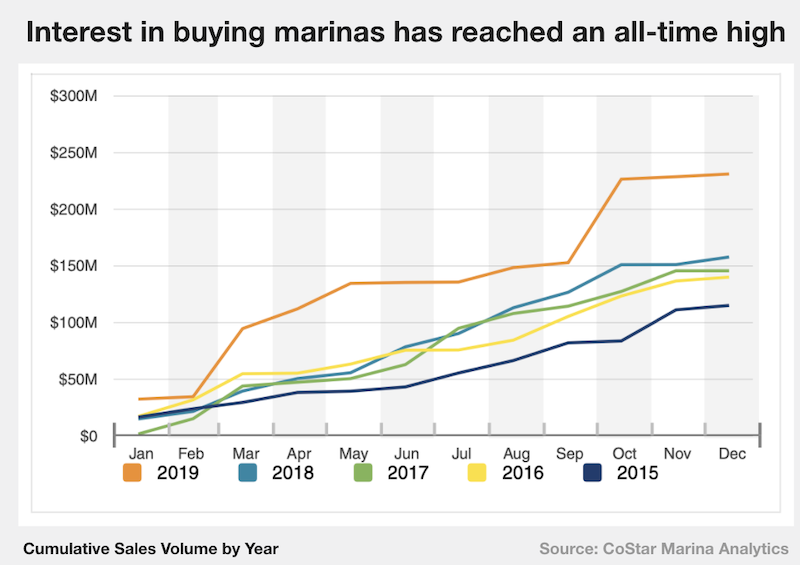We are at a watershed moment for the marina industry - one which will change the face of marina ownership and management for a generation to come. Marinas have always changed hands as owners round out their careers and decide to move on, but historically that change of ownership has been in the form of single purchases – local owner to local owner. Today, we’re entering into a new era of institutional capital and seeing a rise in investors that purchase marinas as part of a larger portfolio of properties. Sale or no sale, that has ramifications for all of us.
We conducted a survey with over a hundred marina owners this month. What stunned us is that a full 40% of those respondents are considering selling their properties in the near future. (Are you part of this group? We've put together an guide on what to consider in selling your marina here). Match that with this chart from CoStar Marina Analytics on the cumulative sales volume by year and you start to see the major transfer of property for which we could be headed. Interest in buying a marina has reached an all time high.

We can have long spirited debates over pints about whether this shift is a good one for the industry, but ahead of all of that we should talk about what this influx of investors means for how marinas are valued and how you can leverage their dataset to understand and increase your own property’s value.
Unlike local buyers, institutional investors have a high dependency on outside capital and therefore a heightened expectation around reporting. They rely on standardized benchmarks and equations to evaluate the return on investment of a given property against a score of others - sometimes thousands of miles away. Without having a sense of those benchmarks yourself or an understanding of where you fit in among comparable marinas, you’re at a disadvantage.
Knowing your benchmarks can certainly help you prepare to sell your property, but it can also help those uninterested in selling better understand and maximize their growth potential in a field growing denser with institutional marinas.
There are a set of static factors that determine your marina’s value, and a set of variable ones. Knowing your baseline value and how the variable levers impact that revenue potential is essential not just for selling your marina tomorrow, but for operating it today.
Knowing Your Marina’s Value
Let’s start with the foundational data points: Occupancy, Average Daily Rate (ADR), and Revenue per Available Linear Foot (RevPALF). You can get a simple equation to make these calculations by downloading this Marina Benchmark Worksheet Template.
Occupancy Rate: Occupancy rate is a measure of how much of your dock space is rented to customers over a given period of time. While each marina is different in terms of how their docks are configured, every marina has a finite and calculable amount of space, measured in total lineal feet The total lineal feet of dock space is the sum of all your finger piers and face docks and is either occupied with seasonals or transients or empty slots.
Average Daily Rate (ADR): Average Daily Rate is a metric used to indicate the average revenue earned for a given occupied slip or mooring on a given day. Rates can vary widely by season or slip, but ADR gives you a common base by which to judge your earning potential at full capacity.
Revenue per Available Linear Foot ("RevPALF"). Revenue per Available Linear Foot is a combination metric that enables you to assess your asset productivity over a given period of time. This is the key to unlocking your marina’s potential revenue which is a major factor in benchmarking your value.
Finding the Right Comp Set of Marinas
In a local sale your marina may be the only one in the water or comparable to a small subset of nearby properties. In an institutional sale however, location is only one factor to consider in benchmarking value. Every marina owner should have a short list of properties that can serve as points of comparison. Not only is this data good for conveying value to others, it’s telling for finding new levers of growth for your own strategy.
A strong comp set should include 3 to 5 marinas with the a subset of the following similar characteristics:



SUBMIT YOUR COMMENT